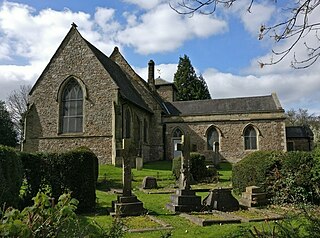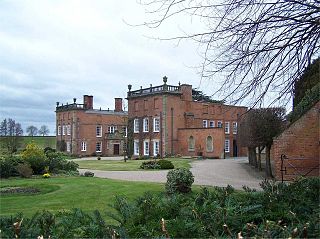
Kirby Muxloe is a large village and civil parish that forms part of the Blaby district of Leicestershire, England. Located to the west of Leicester, its proximity to the city has resulted in its inclusion in the Leicester Urban Area. The Leicester Forest East parish border runs along the Hinckley Road A47. According to the 2001 census, the parish had a population of 4,523, which had increased to 4,667 at the 2011 census.

Ashby de la Zouch Castle is a ruined fortification in the town of Ashby-de-la-Zouch, Leicestershire, England. The castle was built by William, Lord Hastings, a favourite of Edward IV, after 1473, accompanied by the creation of a 3,000-acre (1,200 ha) park. Constructed on the site of an older manor house, two large towers and various smaller buildings had been constructed by 1483, when Hastings was executed by Richard, Duke of Gloucester. The Hastings family used the castle as their seat for several generations, improving the gardens and hosting royal visitors.

Blaby is a local government district in Leicestershire, England. The district is named after the village of Blaby, although the council is based in Narborough. The district covers an area lying south-west of the city of Leicester. Several of the district's settlements form part of the wider Leicester Urban Area, including Glenfield, where Leicestershire County Council has its headquarters at County Hall, and the town of Braunstone.

Kirby Muxloe Castle, also known historically as Kirby Castle, is a ruined, fortified manor house in Kirby Muxloe, Leicestershire, England. William, Lord Hastings, began work on the castle in 1480, founding it on the site of a pre-existing manor house. William was a favourite of King Edward IV and had prospered considerably during the Wars of the Roses. Work continued quickly until 1483, when William was executed during Richard, Duke of Gloucester's, seizure of the throne. His widow briefly continued the project after his death but efforts then ceased, with the castle remaining largely incomplete. Parts of the castle were inhabited for a period, before falling into ruin during the course of the 17th century. In 1912, the Commissioners of Work took over management of the site, repairing the brickwork and carrying out an archaeological survey. In the 21st century, the castle is controlled by English Heritage and open to visitors.

Braunstone is a town and civil parish in the district of Blaby in Leicestershire, England. At the 2011 census the population of the town was 16,850.

Belgrave Hall is a Queen Anne-style Grade II* listed building in Belgrave, on the northern edge of Leicester, England.

Kirby Hall is a Grade I listed Elizabethan country house, located near Gretton, Northamptonshire, England. The nearest main town is Corby. One of the great Elizabethan houses of England, Kirby Hall was built in 1570 for Sir Humphrey Stafford of Blatherwick. In 1575, Sir Christopher Hatton of Holdenby purchased the property, Hatton was Lord Chancellor to Queen Elizabeth I. It is a leading and early example of the Elizabethan prodigy house. Construction on the building began in 1570, based on the designs in French architectural pattern books and expanded in the Classical style over the course of the following decades. The house is now in a semi-ruined state with many parts roof-less although the Great Hall and state rooms remain intact. The gardens, with their elaborate "cutwork" design, complete with statues and urns, have been recently restored.

John Dunn-Gardner, of Soham Mere and of Chatteris House, Isle of Ely, in Cambridgeshire was a British politician and landowner. From his birth until his de-legitimization in 1843 he was the eldest legal son and heir apparent of George Townshend, 3rd Marquess Townshend (1778-1855), who was not however his biological father. He is otherwise notable in relation to the tangled marital history of his mother, the Marchioness Townshend.
This is a list of Sheriffs and High Sheriffs of Leicestershire, United Kingdom. The Sheriff is the oldest secular office under the Crown. Formerly the High Sheriff was the principal law enforcement officer in the county but over the centuries most of the responsibilities associated with the post have been transferred elsewhere or are now defunct, so that its functions are now largely ceremonial. Under the provisions of the Local Government Act 1972, on 1 April 1974 the office previously known as Sheriff was retitled High Sheriff. The High Sheriff changes every March.

Winstanley Hall is a late 16th-century house in Winstanley, in the Metropolitan Borough of Wigan, Greater Manchester, England. It is listed as a Scheduled Ancient Monument and a Grade II* listed building. Originally built for the Winstanley family, the building is one of only three Tudor buildings in the Borough.
Sir William Herle (1270–1347) was a British justice. He was first appointed as an attorney for the Common Bench in 1291, and was appointed as a Serjeant-at-law for the Bench in 1299 and was in regular attendance until 1320. In 1315 he was made a King's Serjeant, and in 1320 replaced John Benstead as a junior justice for the Common Bench, being knighted in the same year. He was absent from the court for three terms in 1321 while sitting as a justice on an Eyre in London with Hervey de Stanton, but otherwise served continuously as a junior justice until he replaced Stanton as Chief Justice in 1327. He left in 1329 to serve on two Eyres in Nottinghamshire and Derbyshire, and returned in 1331. He left again in 1333, although he returned the same year, serving until 1335, making him one of only two Chief Justices of the Common Pleas to be appointed and then leave on three separate occasions; the other, Sir John Stonor, was his replacement on two of those occasions. He lived for another twelve years after retirement, dying in 1347.

Longford Hall is a 16th-century country house at Longford in the Dales district of Derbyshire, England. It is a Grade II* listed building.

Braunstone Park & Rowley Fields is an electoral ward and administrative division of the city of Leicester, England. It comprises the western Leicester suburbs of Braunstone Frith, Braunstone Park and Rowley Fields.

Narborough Hall is a Grade II* listed building in Narborough in Leicestershire. Believed to date from 1596 this Elizabethan manor house was built by James Meade, a local landowner. However, it was only after it was extensively remodelled in the mid-19th century that it became known as Narborough Hall. It is notable because of its construction from local pink granite.

Soughton Hall is a Grade II* listed country house hotel in Sychdyn, Flintshire, Wales. Notable guests that have stayed include Luciano Pavarotti, Michael Jackson and King Juan Carlos I of Spain. William John Bankes inherited Soughton Hall in the 1815.

Henry Dawkins II was a Jamaican plantation and slave owner and Member of the Parliament of Great Britain (MP).
James Winstanley was a British lawyer and Tory politician.

James Tait FRIBA FRIBA was an architect based in Leicester.





















